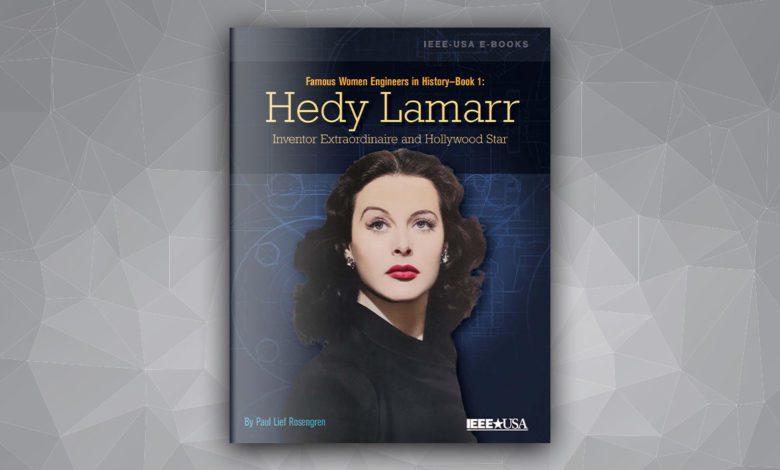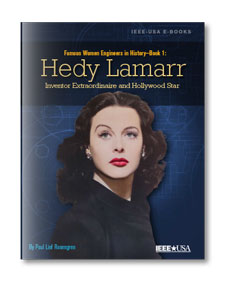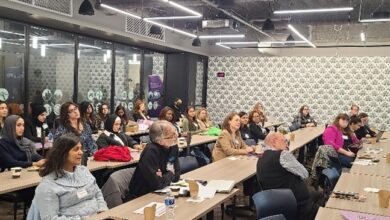
A few months ago, Harry Roman, a prolific author for IEEE-USA E-BOOKS, posted a Call for Authors on LinkedIn to write e-books about historical women engineers. I saw the post, having worked in the past with Harry at PSE&G, and responded. It led to me not just writing the first book in the series, on Hedy Lamarr, but also starting a regular freelance writing relationship with IEEE-USA.
I admit when I agreed to write the book, the only thing I knew about Hedy Lamarr was that she was parodied in Blazing Saddles (for which she sued Mel Brooks).

Famous Women in Engineering History – Book 1: Hedy Lamarr
FREE to Members
Non-Members: $2.99
I soon learned that Lamarr was a fascinating and multi-faceted inventor and one of the leading movie stars of her day. She started her movie career in Europe, when she was just 18. Her performance in the film Ecstasy led to the movie being banned in America on moral grounds — and banned in Germany because she had been born a Jew. In Italy, Mussolini is said to have obtained his own personal copy of the film.
At one time, Lamarr was married to the second richest man in Austria (an arms dealer); she was described as the most beautiful woman in the world; and she raised millions for the U.S. war effort by selling war bonds at rallies. Lamarr starred in 25 Hollywood films, along such actors as Clark Cable (Boom Town), Spencer Tracy (Tortilla Flat), Jimmy Stewart (Come Live with Me) and Judy Garland (The Siegfried Girls). Her biggest hit was in 1949 when she starred as Delilah in Cecil B. DeMille’s Samson and Delilah, opposite Victor Mature (Angela Lansbury had a supporting role).
Of course, none of these accomplishments are why IEEE-USA chose a biography of Lamarr to lead off the new series on famous women engineers in history.
Lamarr was chosen because her inquisitiveness and ideas have had a profound impact on our lives — even though the importance of her technology contributions were not recognized for decades.
During World War II, Lamarr was concerned that most American torpedoes were failing to hit their targets, in part because the guidance systems were being jammed. She had picked up some knowledge of guidance systems from her first husband (he brought her to business meetings to keep an eye on her). Lamarr used this knowledge to develop a way of changing the frequency used by torpedo guidance systems, so that they could avoid jamming. She patented the idea with a co-inventor, George Antheil, and pitched it to the Navy. Eventually the government seized and classified the patent — and then ignored it.
A search of patents after the war led the Department of Defense to use the technology during the Bay of Pigs invasion in the 1960s. More importantly, private-sector businesses adopted the concept of regularly changing frequencies in a pattern known only to sender and receiver; it has become a fundamental component of wireless communication. It is likely that at some point today you will use a devise that incorporates Lamarr and Antheil’s technology — though they never received any compensation for the discovery.
Lamarr also assisted Howard Hughes, helping him design faster planes (he had a movie trailer turned into a lab so that Lamarr could conduct experiments during her downtime on the set), and she never stopped tinkering with ways to improve the world around her.
Unfortunately for Lamarr, her intellect was often overlooked or discredited because she had no academic credentials, came from Austria, was a movie star, or because she was a woman. She was told early in life that she was “simply too beautiful to pursue her interest in science.”
If this short glimpse into Hedy Lamarr’s life has intrigued you, I encourage you to download the book to explore more stories about her extraordinary life, and find out more details on her inventions. Famous Women in Engineering History — Book 1: Hedy Lamarr — Inventor Extraordinaire and Hollywood Star is available to IEEE members for free at IEEE-USA’s Online Shop. Non-members for pay $2.99
In the foreword of the book, Georgia C. Stelluto, Editor, IEEE-USA E-BOOKS, explains that the famous women in history that will be featured in the series “opened the way for others in engineering through their courage, creativity, perseverance and achievement. The long list of role models is a reservoir of inspiration.”
I, for one, look forward to future installments.
Paul Lief Rosengren is the coauthor of In the Time of Covid: One Hospital’s Struggles and Triumphs. He worked for more than three decades in communications at NBC, PSE&G and in state government. He has a Master’s in Public Policy from The Kennedy School of Government, Harvard; and an undergraduate degree in political science from Dickinson College.






